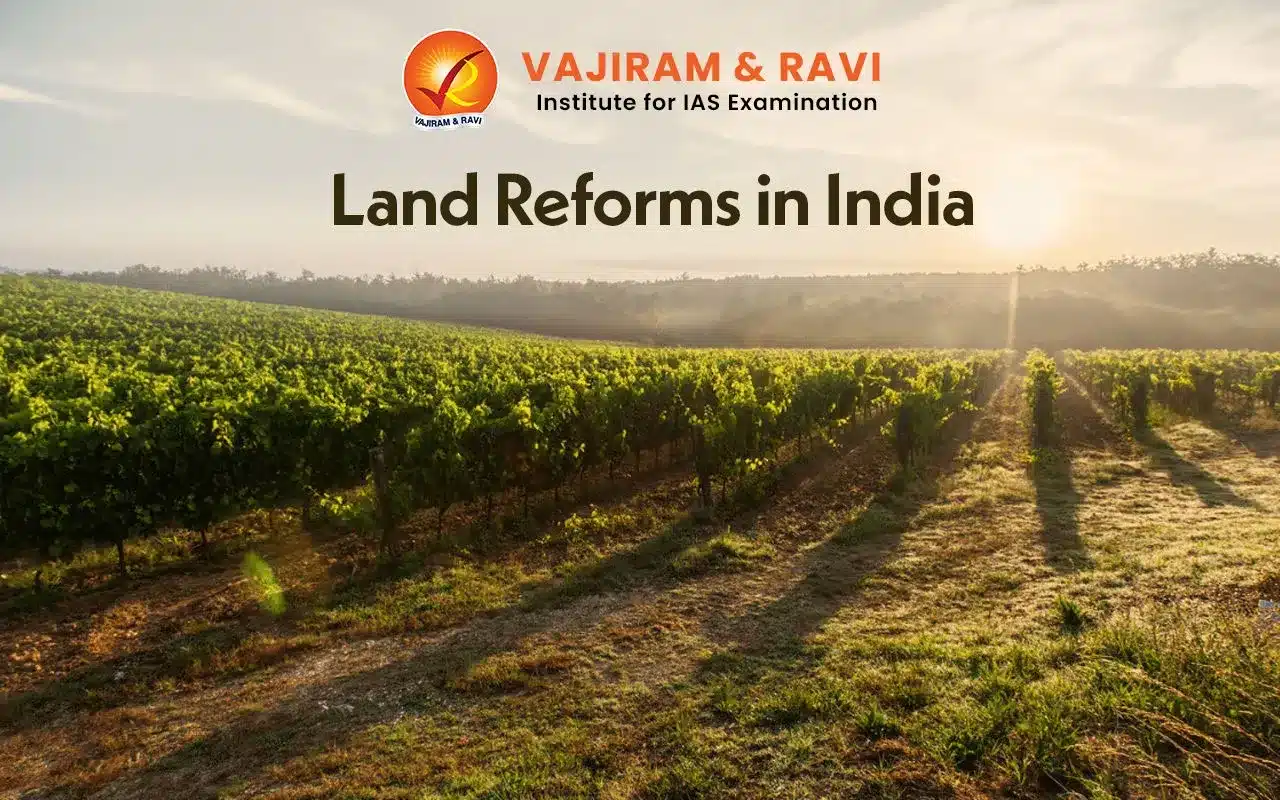Land reforms in India were initiated to address the deep-rooted inequalities in land ownership and promote social justice. Post-independence, these measures focused on abolishing exploitative systems like zamindari, redistributing surplus land to the landless, and providing secure tenancy rights to cultivators. By empowering marginalized communities and ensuring equitable access to agricultural resources, the reforms aimed to create a more inclusive agrarian economy and reduce rural poverty.
However, the success of land reforms has been uneven due to challenges such as ineffective implementation, resistance from landlords, and inadequate land record management. While these reforms transformed many rural areas, persistent inequalities and inefficiencies highlight the need for continuous efforts to ensure equitable land distribution.
Land Reforms in India Overview
Land reforms in India refer to a series of measures aimed at addressing the unequal distribution of land and ensuring social justice by redistributing land to the landless, regulating ownership, and improving tenancy conditions. These land reforms were shaped by the historical context of exploitative colonial agrarian systems, such as the Zamindari and Ryotwari System, which had created a class of intermediaries and left cultivators in a state of subsistence.
- Post-Independence Land Reforms: Land reforms in India were primarily state-led and followed a top-down approach, aligned with national policies under the Five-Year Plans.
- State and Central Role in Land Reforms: Land reform remains a state subject, with states formulating policies based on specific needs, guided by central frameworks like those introduced during the Green Revolution.
- Government Agenda: While initiatives like the Telangana and the Bhoodan movements made some localized contributions, the broader agenda was driven by government efforts to reduce exploitation and promote both economic development and political stability in rural India.
Background of Land Reforms India
The background of land reforms in India can be traced to the colonial agrarian systems established by the British, which left the rural population marginalized and exploited. After Independence, these historical issues prompted the Indian government to initiate land reforms aimed at addressing socio-economic inequalities and promoting social justice.
Pre-Independence Period
Pre-Independence land reforms in India were shaped by the British colonial administration's economic and political goals. The land revenue systems in British India, including the Zamindari, Ryotwari, and Mahalwari systems, were designed to extract revenue from the agrarian economy, often leading to the exploitation and impoverishment of the peasantry.
- Zamindari System (1793): The ownership of the land was conferred upon the native tax collector and cultivators became mere tenants-at-will in their fields.
- Ryotwari System (1820): No intermediary proprietors were recognized and actual tillers were vested with a heritable and transferable right of property in their lands.
- Mahalwari System (1822): The state made settlements with the village community. Each such fiscal unit was called a ‘mahal’ and some recognition was given to collective proprietary rights.
Post-Independent Period
After Independence, the Indian National Congress (INC) appointed the Agrarian Reforms Committee headed by J.C. Kumarapppa, to conduct a study of the agrarian relations prevailing in the country. Based on the recommendation of the committee, states enacted legislation for the abolition of intermediary tenures in the 1950s.
- Bhoodan and Gramdan Movements (1951): It was launched by Acharya Vinoba Bhave, in Andhra Pradesh, and had the purpose of appealing to landowning classes to donate their surplus land to the poor.
- It created awareness about the issue of landlessness and brought it to the forefront of public discourse.
- The Emergence of Gramdan (1955): It was also started by Vinoba Bhave to establish self-governing and self-reliant village communities where the resources, including land, would be collectively owned and managed.
- Five-Year Plans (FYPs): The basic orientation of land policy set by the FYPs was to provide a framework for economic development and political stability.
- Objectives: The objectives were to remove such impediments in agricultural production arising from the agrarian structure inherited from the past and eliminate all elements of exploitation and social injustice within the agrarian system.
Objectives of the Land Reforms in India
In an agrarian economy like India, where land scarcity and inequality were coupled with widespread rural poverty, land reforms became a critical priority after Independence. The following are the main objectives of land reforms in India:
- Social Justice: Eradicate feudalism, transfer land to the landless, and promote social and economic equality.
- Increased Agricultural Productivity: Allocate land for efficient farming to maximize its potential.
- Poverty Alleviation: Distribute land to the landless to improve their socioeconomic status and reduce rural poverty.
- Tenancy Reforms: Protect tenants' rights, ensure tenure security, establish fair rents, and prohibit unjust eviction.
- Land Holdings Consolidation: To improve agricultural output and cultivation efficiency, and avoid land fragmentation.
- Enhanced Socioeconomic Conditions: They also aimed to reduce rural poverty, improve tenant security, create a more equitable society, and enhance agricultural productivity.
Components of Land Reforms in India
The components of land reforms in India encompass a range of legislative and administrative measures aimed at transforming the agrarian structure. These reforms sought to address land inequality, enhance agricultural productivity, and improve the socio-economic conditions of rural populations. Key components of land reforms in India are as follows:
Abolition of Intermediaries
Legislative measures aimed at abolishing intermediary tenures began with the enactment of the Zamindari Abolition and Land Reform Act of 1950.
- Key Elements of the Zamindari Abolition Act: The Zamindari Abolition Act was a significant step in India's land reform process, aimed at ending the exploitative intermediary system and promoting direct ownership of land by the tillers.
-
-
- Abolition of Rights: It abolished all rights of Zamindars and Jagirdars and banned further acquisition of land.
-
- Compensation to Landowners: The abolition of intermediary tenures affected the compensation payment to the landowners.
-
- Relief for Peasantry: The vast mass of the peasantry was freed from all illegal exactions in cash, kind, and services.
- Creation of Land Records: Land records were created and surveys and settlements were carried out in these areas.
- Demarcation of Holdings: Holdings were demarcated based on the individual as a unit.
- Challenges: The removal of intermediaries strained the state's finances with hefty compensation paid. Former landlords retained control, displacing many tenants. Absentee landlords rose in prominence, worsening land ownership problems.
Tenancy Reforms
Tenancy reforms in India aimed to address issues related to the leasing of land, high rents, and insecurity of tenure. The reforms focused on three important guidelines:
- Rent: The rent should not exceed one-fifth to one-fourth of the gross produce. It aimed to ensure fair and reasonable rent for tenants.
- Security of Tenure: All tenancies should be declared non-resumable and permanent, except in certain specified circumstances. This guideline aimed to provide security to tenants, allowing them to make improvements to the land and receive a fair share of the produce.
- Ownership Rights: In the case of non-resumable land, the landlord-tenant relationship should be terminated by conferring ownership rights on tenants. This guideline aimed to eliminate absentee landlordism and provide tenants with ownership rights.
- Challenges: The failure to ensure full security for the tenants has been attributed to the deficiencies in the Act, the absence of proper land records, weak administrative machinery, etc.
- Where tenancy has been abolished, concealed tenancy is being carried out under the guise of personal cultivation.
- Reverse tenancy is increasing in areas benefiting from the Green Revolution strategy, as small landholdings are not compatible with developed technology, reducing them to agricultural labourers.
Ceiling on Landholdings
To reduce the extent of inequality in the ownership of land, the land ceiling legislation was implemented in two phases.
- Phase 1: Pre-Revised Ceiling Laws (1960-1972): During the Second FYP, the debate over applying ceiling laws to families or individuals arose. Land transfers within families often contradicted legislative goals. Balancing disparities from different ceiling laws posed a challenge.
- Phase II: Revised Ceiling Laws after National Guidelines (1972): The Central Land Reforms Committee, 1971, reviewed the ceiling legislation due to its ineffectiveness, agrarian unrest, and agricultural production demands.
-
- It laid down national guidelines for future land ceiling legislation.
- Implementation and Progress: The implementation of ceiling laws varied across states, and most of the laws were included in the Ninth Schedule of the Indian Constitution, providing immunity against legal challenges.
- Continued Challenges of Exemptions: Despite the revisions, certain categories of land remained exempt from the ceiling, creating opportunities for evasion through the transfer of lands to these exempted categories.
- Jurisdiction of Civil Courts was barred in respect of land reform cases because of their inclusion in the Ninth Schedule of the Constitution in 1990.
Impact of Land Reforms in India
The land reforms in India had a significant impact on transforming the agrarian structure by breaking the power of intermediaries and promoting direct land ownership among cultivators. As a result, these reforms led to the following outcomes, shaping the agricultural and social landscape of rural India.
- Increased Productivity: Security of tenure and distribution of land has resulted in the occupants of the land taking an interest in its development and increasing its productivity.
- Protected Tenancy Status: It has been strengthened by making provisions in the law regarding termination of tenancy, Green Revolution eviction of tenants, surrender by tenants, and purchase of tenanted land by the tenants.
- Land Possession: Land provides not only economic benefits but also social prestige. Land reforms made it necessary to keep records of holdings, which had previously been optional.
- Financial Burden on Landowners: Landowners, particularly absentee landlords, have had to incur substantial expenses and seek the assistance of legal professionals and bureaucracy to circumvent the ceiling laws.
Shortcomings of Land Reforms in India
While land reforms in India have brought about significant changes, they have also faced numerous shortcomings that hindered their full implementation and effectiveness. These challenges, ranging from weak political will to legal loopholes, have impeded the intended impact of land reforms on the agrarian structure.
- Lack of Strong Political Will: Because land reforms are a state subject, the Central Government's role was limited to developing broad guidelines and persuading state governments to put them into execution.
- The state government's political will to enforce the legislation was weak in most states, and the bureaucracy was largely indifferent.
- Land Records: The successful implementation of land reforms heavily relies on accurate and up-to-date land records. In many states, land records have not been adequately maintained.
- Loopholes in Land Distribution: There is still a significant gap between land distribution and actual occupation by beneficiaries, which is hampered by physical prevention and litigation (beneficiaries such as landless labourers and poor peasants cannot afford it).
- Protection of Tribal Lands: In all the scheduled areas, land transfer from tribal to non-tribal population was prohibited by law. However, due to several legal loopholes and administrative errors, the tribals' alienation from their land persisted on a vast scale.
- Identification of Benami Land: It is the land held under a different name to circumvent the law. It is not possible through the efforts of the administration alone. For this, support of the local organizations of the beneficiaries or the organizations representing the interest of the beneficiaries of land distribution is necessary.
- Malafide Transfer of Land: To avoid the regulations governing land ceilings, the Zamindars have engaged in extensive land transfers to family members or kinsmen.
- Such malafide transactions do not make any change in the operational aspect of agriculture.
Land Reforms in India UPSC PYQs
Question 1: Critically discuss the objectives of Bhoodan and Gramdan Movements initiated by Acharya Vinoba Bhave and their success. (UPSC Mains 2013)
Question 2: With reference to land reforms in independent India, which one of the following statements is correct? (UPSC Prelims 2022)
- The ceiling laws were aimed at family holdings and not individual holdings.
- The major aim of land reforms was providing agricultural land to all the landless.
- It resulted in cultivation of cash crops as a predominant form of cultivation.
- Land reforms permitted no exemptions to the ceiling limits.
Answer: (b)
Last updated on November, 2025
→ Check out the latest UPSC Syllabus 2026 here.
→ Join Vajiram & Ravi’s Interview Guidance Programme for expert help to crack your final UPSC stage.
→ UPSC Mains Result 2025 is now out.
→ UPSC Notification 2026 is scheduled to be released on January 14, 2026.
→ UPSC Calendar 2026 is released on 15th May, 2025.
→ The UPSC Vacancy 2025 were released 1129, out of which 979 were for UPSC CSE and remaining 150 are for UPSC IFoS.
→ UPSC Prelims 2026 will be conducted on 24th May, 2026 & UPSC Mains 2026 will be conducted on 21st August 2026.
→ The UPSC Selection Process is of 3 stages-Prelims, Mains and Interview.
→ UPSC Result 2024 is released with latest UPSC Marksheet 2024. Check Now!
→ UPSC Prelims Result 2025 is out now for the CSE held on 25 May 2025.
→ UPSC Toppers List 2024 is released now. Shakti Dubey is UPSC AIR 1 2024 Topper.
→ UPSC Prelims Question Paper 2025 and Unofficial Prelims Answer Key 2025 are available now.
→ UPSC Mains Question Paper 2025 is out for Essay, GS 1, 2, 3 & GS 4.
→ UPSC Mains Indian Language Question Paper 2025 is now out.
→ UPSC Mains Optional Question Paper 2025 is now out.
→ Also check Best IAS Coaching in Delhi
Land Reforms in India FAQs
Q1. What is meant by land reforms?+
Q2. What was the most successful land reform in India?+
Q3. What are the main objectives of land reforms?+
Q4. What are the limitations of land reforms in India?+
Q5. What is the Zamindari Abolition Act?+
Tags: land reforms in india quest

















